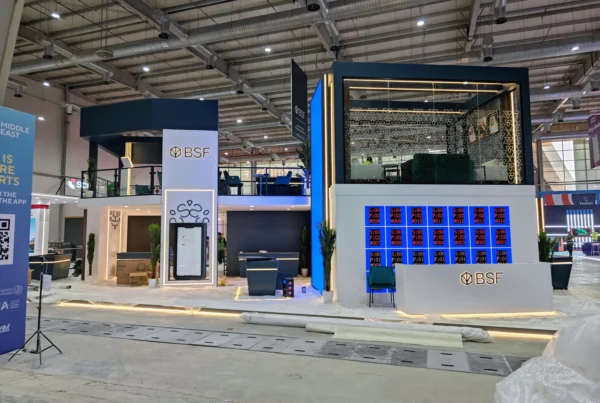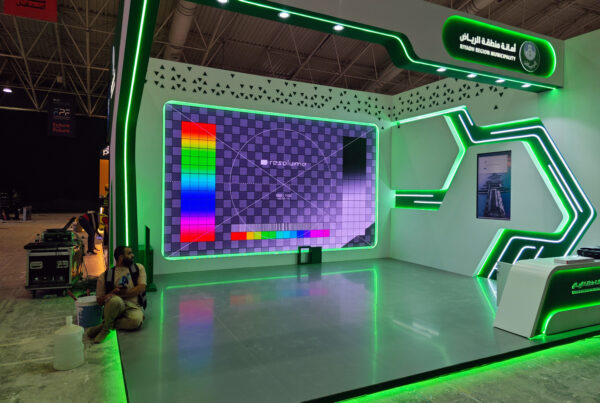In an era of evolving attendee expectations, delivering immersive event technology experiences has become essential. Gone are the days of passive presentations; today’s audiences crave immersive event experiences that respond to their presence, interests, and input. Yet, merging innovation with budget discipline can feel challenging. Balancing costs and cutting-edge interactive technology for events requires strategic thinking, careful vendor selection, and a deep understanding of how these technologies truly enhance engagement.
In this article, we’ll break down the key cost drivers, reveal best practices for making the most of your funds, and show how thoughtful planning transforms expenses into smart investments. Leveraging insights from industry leaders like PCMA and MPI, along with our own experiences creating immersive solutions, you’ll learn how to deliver impactful interactive event technology without overspending.
Defining Immersive Event Technology
Immersive event technology brings together advanced tools—AR/VR, interactive screens, real-time 3D simulations, and responsive content—to engage participants deeply. Instead of static visuals, attendees experience immersive event tech that adapts to their actions, making them active participants rather than passive observers.
For a closer look at maximizing brand impact through such tools, explore Immersive Interactive Technology for Events. Understanding these capabilities helps you prioritize which interactive event technology elements best fit your objectives and resources.
Key Cost Drivers of Immersive Event Technology
Budgeting for immersive event solutions involves more than just hardware rental fees. Consider these factors:
- Hardware and Equipment:
High-quality displays, AR/VR headsets, projection systems, sensors, and servers form the backbone of immersive experiences. Costs vary widely depending on scale and sophistication. - Software and Content Creation:
Developing custom interactive content—like virtual worlds rendered in Unreal Engine—can be a significant investment. While these efforts yield compelling attendee journeys, they require skilled designers, programmers, and possibly licensing fees. - Integration and Infrastructure:
Connecting event interaction technology with existing AV systems or multiple interactive solutions calls for technical integration. Specialized services may be needed to ensure seamless performance. - On-Site Staffing and Support:
Skilled technicians, experience designers, and support teams ensure that immersive experiences run smoothly. More complex setups typically demand more hands on deck. - Venue and Logistics:
Venue conditions—lighting, internet connectivity, room layout—impact equipment choices and complexity. Tailoring immersive solutions to these parameters can influence costs.
Balancing Investment and Impact
According to PCMA’s 2025 Trends Report and insights from MPI, rising tech costs push event planners to focus on ROI. Instead of defaulting to the flashiest tools, select immersive event tech that solves real attendee challenges:
- Audience-Centric Strategy:
Identify what participants truly need. For instance, AR navigation could help them find sessions faster, while interactive touchscreens could boost networking and lead capture. Each feature should fulfill a clear purpose. - Repurposing Assets and Scalability:
Consider content and hardware that can be adapted for future events or multiple use cases. For example, the digital twin approach in our Jeddah Central Development Company Digital Twin Project shows how assets can evolve over time, spreading costs and maintaining relevance. - Phased Implementation:
Start small—pilot a single AR demo station or an interactive kiosk—then expand once you’ve measured engagement and confirmed value. Gradual adoption helps mitigate risk and refine spending strategies.
Vendor Selection and Negotiation for Immersive Event Technology
The right vendor can make or break your budget. When planning immersive event technology:
- Request Detailed Breakdowns:
Ask for itemized quotes to understand each cost driver. Transparency helps you identify where to save and where to invest more for greater impact. - Rental vs. Purchase Decisions:
If your immersive experience is a one-time showcase, renting devices may be cost-effective. For recurring events, owning key components or building long-term partnerships with suppliers might be cheaper overall. - Check Reviews and Credentials:
Explore industry forums, professional associations like MPI, or case studies to find vendors with a track record of delivering quality and meeting budgets. Prioritize those who offer flexible pricing models and post-event support.

Measuring ROI and Justifying Costs
It’s essential to track the effectiveness of immersive event experiences. Assess metrics like attendee dwell time, lead quality, social media mentions, and post-event surveys. Analytics integrated into interactive installations offer tangible evidence of which features resonate most.
For insights on enhancing customer satisfaction through immersive technology, see 5 Ways Immersive Event Technology Enhances Your Customer Experience Strategy. When you can link immersive tech to meaningful outcomes—such as higher engagement or sales pipeline growth—justifying expenditures becomes far easier.
Learning from Real-World Examples
Case studies provide valuable perspective. Our Saudi Cup 2023: Equestrian Authority Activations demonstrate how carefully chosen immersive solutions boosted brand interaction and event prestige. By examining other success stories and lessons learned, you can make more informed decisions tailored to your event’s scale and goals.
Planning for Future Evolution of Immersive Event Technology
As technology advances, new immersive event technology formats—like metaverse-inspired experiences or AI-driven personalization—will shape tomorrow’s events. By anticipating these trends, you can budget proactively. Gradual integration of emerging tech allows you to spread costs and refine strategies, maintaining a competitive edge without overwhelming budgets.
Industry groups like PCMA and MPI regularly publish reports, offering the latest insights on balancing cost and innovation in the dynamic landscape of immersive event technology.
Taking Action: Your Next Steps
Investing wisely in interactive event technology and immersive event solutions is about understanding your audience, choosing the right tools, and continuously measuring results. Start by identifying the features most likely to deliver tangible value, negotiate transparent vendor contracts, and scale gradually. By adopting this approach, you can create immersive event experiences that captivate attendees and deliver measurable ROI—without straining your budget.
Ready to transform your events? Contact Us at Chameleon Interactive to discuss tailored immersive solutions that align with your strategic and financial objectives.
Key Takeaways
- Focus on Purpose: Select immersive elements that solve real attendee needs.
- Budget Transparency: Seek itemized quotes and compare rental versus purchase options.
- Measure ROI: Track engagement, leads, and satisfaction to justify costs and refine strategies.
- Start Small, Scale Later: Test one or two immersive features first, then expand based on proven value.
- Stay Informed: Monitor industry trends and insights from organizations like PCMA and MPI to remain agile.
FAQ: Budgeting and Planning for Immersive Event Technology
1. What are the main cost drivers when adopting immersive event technology?
Immersive event technology expenses typically include interactive event technology rental fees (e.g., VR headsets, projection systems), software licenses or content creation (like custom AR apps), and on-site technical support. Venue logistics—like internet connectivity or stage design—can also influence how you budget for immersive event solutions.
2. How do immersive event solutions differ from traditional setups?
Unlike static displays or conventional AV setups, immersive event solutions offer dynamic engagement through real-time 3D environments, AR/VR stations, and multi-sensory elements. This interactivity drives deeper audience participation, creating memorable experiences rather than passive presentations.
3. When should event planners consider interactive technology for events over standard formats?
Anytime you’re seeking to boost attendee engagement, differentiate your brand, or gather robust data on user interactions, interactive technology for events is a smart choice. It helps capture audience attention, fosters emotional connections, and can streamline lead generation by offering tailored, hands-on experiences.
4. How does immersive event tech provide tangible ROI for organizers?
By using immersive event tech—from digital twin demos to AR-based product showcases—planners can spark higher dwell times, more social media buzz, and stronger post-event conversions. This measurable uplift in attendee satisfaction and lead quality often justifies the initial investment in event technology solutions.
5. Where can we find guidance on balancing innovation and budget for immersive events?
Resources like Planning Your Budget: How to Invest Wisely in Immersive Event Technology Solutions outline best practices. From choosing the right interactive technology for events to negotiating vendor contracts, these strategies help ensure you deliver compelling experiences while keeping costs under control.


